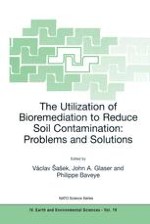2003 | OriginalPaper | Buchkapitel
Biopiles for Remediation of Petroleum-Contaminated Soils: A Polish Case Study
Polish Refinery Biopile
verfasst von : T. C. Hazen, A. J. Tien, A. Worsztynowicz, D. J. Altman, K. Ulfig, T. Manko
Erschienen in: The Utilization of Bioremediation to Reduce Soil Contamination: Problems and Solutions
Verlag: Springer Netherlands
Enthalten in: Professional Book Archive
Aktivieren Sie unsere intelligente Suche, um passende Fachinhalte oder Patente zu finden.
Wählen Sie Textabschnitte aus um mit Künstlicher Intelligenz passenden Patente zu finden. powered by
Markieren Sie Textabschnitte, um KI-gestützt weitere passende Inhalte zu finden. powered by
The US Department of Energy and the Institute for Ecology of Industrial Areas of Poland demonstrated bioremediation techniques for the cleanup of acidic petroleum sludge impacted soils at an oil refinery in southern Poland. The waste was composed of high-molar mass paraffinic and polynuclear aromatic hydrocarbons. Benzo(a)pyrene and BTEX compounds were identified as the contaminants of concern. Approximately 3 300 m3 of contaminated soil (TPH ∼ 30 000 ppm) was targeted for treatment. A biopile design which employed a combination of passive and active aeration in conjunction with nutrient and surfactant application was used to increase the biodegradation of the contaminants of concern. Over the 20 month project, more than 81 % (120 metric tons) of petroleum hydrocarbons were biodegraded. Despite the fact that the material treated was highly weathered and very acidic, biodegradation rates of 121 mg per kg soil per day in the actively aerated side (82 mg per kg soil per day in the passive side) were achieved in this biopile. Microbial counts and dehydrogenase measurements gave the best correlation with the biodegradation rates. Costs were competitive or significantly lower when compared with other ex situ treatment processes.
